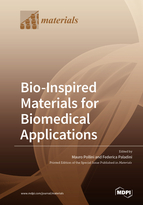Bio-Inspired Materials for Biomedical Applications
A special issue of Materials (ISSN 1996-1944). This special issue belongs to the section "Biomaterials".
Deadline for manuscript submissions: closed (31 October 2020) | Viewed by 21408
Special Issue Editors
Interests: tissue engineering; bioengineering; antibacterial treatments; silver; fibroin; sericin; nanocoatings
Special Issues, Collections and Topics in MDPI journals
Interests: wound healing; bioengineering; tissue engineering; silk proteins; infections; silver
Special Issues, Collections and Topics in MDPI journals
Special Issue Information
Dear Colleagues,
Nature is an incredible source of inspiration for scientific research and for the development of novel materials for different applications. Biological constructs have inspired the design of a considerable number of biomaterials with a high potential in biomedical and pharmaceutical fields. Biocompatibility, controllable biodegradation, and improved mechanical properties are just some examples of the properties achieved through the appropriate definition of bio-inspired materials for a wide range of biomedical applications, such as tissue engineering, drug delivery, bioactive surface, antimicrobial devices for clinical use, and so on.
From nano- to macro-scale, by investigating the hierarchical structures and living systems in nature, novel effective strategies that mimic the biological environment and constructs can be proposed in order to provide innovative approaches in bioengineering and biotechnology.
This Special Issue aims to collect the most recent advances in the development of bio-inspired materials for biomedical applications, and to provide the reader with examples of the relation between nature and progress in scientific research.
It is our pleasure to invite you to submit a manuscript for this Special Issue. Full papers, short communications, and reviews, would be greatly appreciated.
Dr. Mauro Pollini
Dr. Federica Paladini
Guest Editors
Manuscript Submission Information
Manuscripts should be submitted online at www.mdpi.com by registering and logging in to this website. Once you are registered, click here to go to the submission form. Manuscripts can be submitted until the deadline. All submissions that pass pre-check are peer-reviewed. Accepted papers will be published continuously in the journal (as soon as accepted) and will be listed together on the special issue website. Research articles, review articles as well as short communications are invited. For planned papers, a title and short abstract (about 100 words) can be sent to the Editorial Office for announcement on this website.
Submitted manuscripts should not have been published previously, nor be under consideration for publication elsewhere (except conference proceedings papers). All manuscripts are thoroughly refereed through a single-blind peer-review process. A guide for authors and other relevant information for submission of manuscripts is available on the Instructions for Authors page. Materials is an international peer-reviewed open access semimonthly journal published by MDPI.
Please visit the Instructions for Authors page before submitting a manuscript. The Article Processing Charge (APC) for publication in this open access journal is 2600 CHF (Swiss Francs). Submitted papers should be well formatted and use good English. Authors may use MDPI's English editing service prior to publication or during author revisions.
Keywords
- Biomaterials
- Tissue engineering
- Biomedical
- Bioengineering








